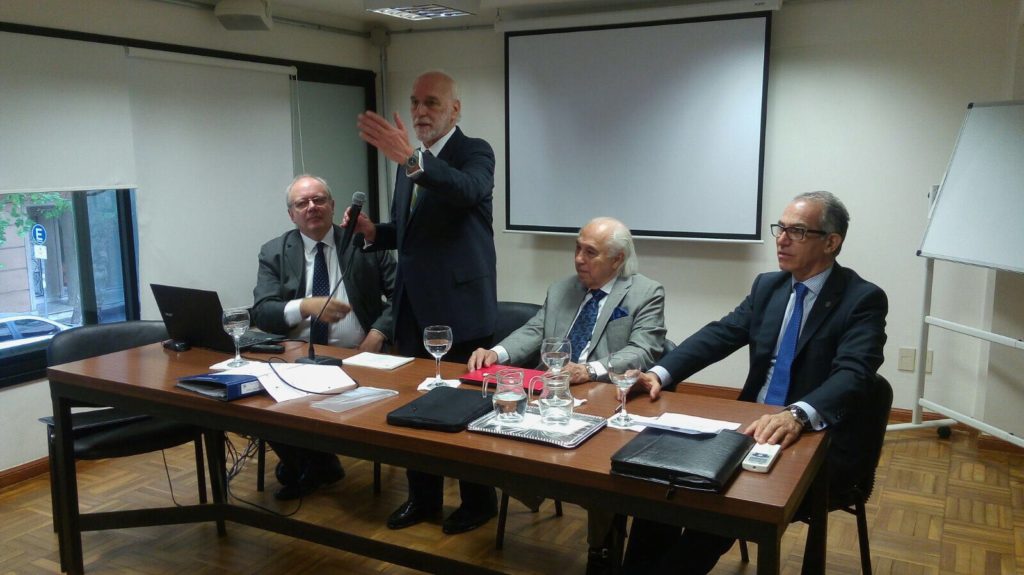
From left to right: Amb. Alberto Guani (Director of Instituto Artigas del Servicio Exterior); Amb. Luiz Filipe de Macedo Soares (Secretary-General of OPANAL); Amb. Sergio de Queiroz Duarte (instructor of the OPANAL Course); Amb. Juan Carlos Ojeda (Director of Multilateral Affairs of the Ministry of Foreign Affairs of Uruguay).
From 11 to 15 December 2017, the Ministry of Foreign Affairs of the Oriental Republic of Uruguay hosted the first OPANAL's Course on Nuclear Disarmament and Non-Proliferation at the Instituto Artigas del Servicio Exterior (IASE) in Montevideo.
The Course was delivered by Ambassador Sergio de Queiroz Duarte, former United Nations High Representative for Disarmament Affairs and current President of Pugwash Conferences on Science and World Affairs.
See the photo gallery.
Requirements to receive the Course Diploma
- 80% attendance.
- Evaluation exercise (in Spanish). The following are evaluation exercises made by the participants:
Comments from Course participants and the instructor
Amb. Sergio de Queiroz Duarte (instructor):
“Fue para mí un gran honor y un placer participar como instructor en el I Curso de OPANAL para jóvenes diplomáticos sobre desarme y no proliferación nuclear. La interacción con los alumnos ha sido muy interesante y pienso que todos hemos podido aprender algo. Las nuevas generaciones tendrán un papel capital en el mantenimiento de la paz y la seguridad internacionales y en legar un mundo libre de armas Nucleares”.
Mr. Nicolás Aquésolo Lupinacci:
El Curso fue una “enriquecedora experiencia.
Programme of the Course on Nuclear Disarmament and Non-Proliferation
Day 1
Introduction
The origin of nuclear weapons
The context of the Cold War
- Nuclear arms race
- Relations between superpowers
Treaty of Tlatelolco
Immediate background
- “Missile Crisis” (October 1962, Cuba)
- Initiatives in the United Nations General Assembly – 1962
- Joint Declaration for the denuclearization of Latin America (issued by the Heads of State of Bolivia, Brazil, Chile, Ecuador and Mexico on 29 April 1963)
- Decision to negotiate the Treaty: Preliminary Meeting on the Denuclearization of Latin America (REUPRAL), 23-27 November 1964
- Negotiation of the Treaty: Preparatory Commission for the Denuclearization of Latin America (COPREDAL), March 1965 to February 1967
Structure of the Treaty of Tlatelolco
- Preamble
- Objectives
- Control System
- Additional Protocols I and II to the Treaty
- Signature and Ratification
- Interpretative declarations
Treaty operations
- Bodies of the Agency for the Prohibition of Nuclear Weapons in Latin America and the Caribbean (OPANAL)
Recent participation of the Member States
- Declarations issued by OPANAL and the Community of Latin American and Caribbean States (CELAC)
Course material - Day 1:
La proscripción de las armas nucleares en la América Latina y el Caribe: resumen de sus principales etapas, by Ambassador Alfonso García Robles.
Declaration by the OPANAL Member States – International Day for the Total Elimination of Nuclear Weapons – 26 September 2017
Day 2
Nuclear disarmament at the global level
Nuclear disarmament
- Multilateral initiatives
- United Nations General Assembly
- Eighteen-Nation Disarmament Committee (ENDC, 1962-1969) - Conference of the Committee on Disarmament (CCD, 1969)
- First Special Session of the General Assembly devoted to Disarmament (SSOD I, 23 May-1 July 1978) - Final Document
- Committee on Disarmament (1979) - Conference on Disarmament (CD, February 1984)
- United Nations Disarmament Commission (UNDC)
- Comprehensive Nuclear-Test-Ban Treaty (CTBT) and Preparatory Commission for the Comprehensive Nuclear-Test-Ban Treaty Organization (CTBTO)
Major themes on nuclear disarmament
- Fissile material
- Negative security assurances
- Outer space
Nuclear weapons and International Humanitarian Law
- International Humanitarian Law and Humanitarian Initiative
- Humanitarian Conferences: Oslo, Nayarit, and Vienna
- Humanitarian Pledge
- Activities of non-governmental organizations
- Public opinion and nuclear disarmament
- Nuclear disarmament and non-proliferation education
Course material - Day 2:
UNODA – Fact sheet – The Conference on Disarmament and negative security assurances
CTBT– Fact sheet
Text of the Comprehensive Nuclear-Test-Ban Treaty (TPCE)
Day 3
Nuclear Non-Proliferation Regime
Nuclear Non-Proliferation Regime
- Treaty on the Non-Proliferation of Nuclear Weapons (NPT):
- Drafting
- Adoption
- Entry into force
- NPT structure
- Review Conferences of the Parties to the Treaty on the Non-Proliferation of Nuclear Weapons
- 1995 NPT Review and Extension Conference
- 2010 NPT Review Conference
- 2015 NPT Review Conference
- Themes of the NPT Review Conference
- Implementation of the NPT provisions on nuclear disarmament (Article VI), as well as international peace and security
- NPT provisions on non-proliferation, safeguards and nuclear-weapon-free zones
- Inalienable right to use nuclear energy for peaceful purposes
Course material - Day 3:
Text of the Treaty on the Non-Proliferation of Nuclear Weapons (TNP)
IAEA safeguards for the non-proliferation of nuclear weapons
Day 4
Nuclear-Weapon-Free Zones
Concept of a nuclear-weapon-free zone
- Establishment of nuclear-weapon-free zones on the basis of arrangements freely arrived at among the States of the region concerned (1999)
Treaties that establish nuclear-weapon-free zones
- South Pacific (Treaty of Rarotonga, 1985)
- Southeast Asia (Treaty of Bangkok, 1995)
- Africa (Treaty of Pelindaba, 1996)
- Central Asia (Treaty on a Nuclear-Weapon-Free Zone in Central Asia, 2006)
- Status of Mongolia as a nuclear-weapon-free State (1992)
Conferences of nuclear-weapon-free zones and Mongolia
- I Conference of States Parties and Signatories to Treaties that establish nuclear-weapon-free zones and Mongolia, Mexico City, 2005
- II Conference of States Parties and Signatories to Treaties that establish nuclear-weapon-free zones and Mongolia, New York, 2010
- III Conference of States Parties and Signatories to Treaties that establish nuclear-weapon-free zones and Mongolia, New York, 2015
Establishment of future nuclear-weapon-free zones
- Northeast Asia
- Establishment of a zone free of nuclear and other weapons of mass destruction in the Middle East (ME-WMDFZ)
- Other United Nations initiatives
Course material - Day 4:
Comparative chart of the five nuclear-weapon-free zones
Day 5
Perspectives
Current situation of nuclear disarmament and non-proliferation policy and perspectives
Evaluation of participants
Course material - Day 5:
